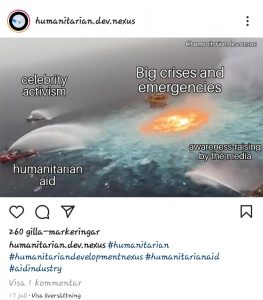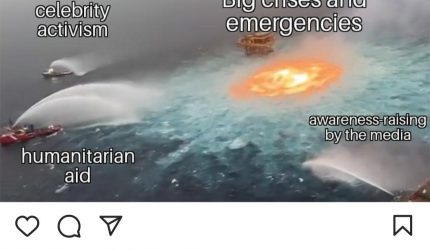 When digging digital development among aid workers, the use of social media could be a way to connect with each other, unifying as a community and strengthening the solidarity with each other. Memes being one of the uses on social media in which they can share their frustration in the aid industry in a satirical, “inside joking” and relieving kind of way.
When digging digital development among aid workers, the use of social media could be a way to connect with each other, unifying as a community and strengthening the solidarity with each other. Memes being one of the uses on social media in which they can share their frustration in the aid industry in a satirical, “inside joking” and relieving kind of way.
Having since long followed the Instagram account @humanitarian.dev.nexus [1] as I appreciate knowing that my frustrations in the aid sector are shared with other humanitarians, I want to share some of their memes and hear your opinion about them. The Instagram profile states “by humanitarians, for humanitarians” and they are followed by accounts such as The New Humanitarian and Globalportalen among other relevant actors in the humanitarian sector. Their relatable memes, which give a sense of community among humanitarians, constitutes a way “to let off steam” (Chonka, 2019: 2) [2] among aid workers.
In his article “#HumanitarianStarWars and Memetic Self-Critique in the Aid Industry”, Chonka (2019) explains that these meme accounts play an important role of scrutiny and auto-critique among humanitarian aid workers, yet with a satirical self-reflection. At heart, these critical memes are used as inside jokes for humanitarians rather than to enlighten the greater mass on problematic issues within the aid industry (ibid, 1-11). This leaves the memes sometimes being very relatable to humanitarians but could also entail negative consequences such as the reinforcement of stereotypes between the majority and minority world.
Furthermore, the focuses in these memes are on the struggle and frustrations of the aid workers environment, which is challenging in its own way, but could also refer to the humanitarian “martyrdom” explored by Neuman (2017) [3] (further discussed in next blog post). For example, this meme pictured beneath relates to the hard work of the field worker, making the aid worker some sort of victim of the work he has chosen him- or herself. At the same time, it illustrates the feelings (in a satirical way) aid workers sometimes are struggling with after finishing a mission relating to their mental health (further discussed in my previous blog post).

Many of the memes illustrate the humanitarians’ constant struggles with their own moral dilemmas, and their need of making a difference, such as these two pictured listed on the right.

This meme (below, right) illustrates the frustration of not being able to make a change, but the locals with their own agency are not even depicted, making them irrelevant as actors and undermining their agency. 
To sum up, in my previous post I brought forward the question regarding dealing with your own mental health and coping mechanisms in connection to taking part in aid work and reflecting on your mental state and its impact on aid work. In this blog post, the use of memes illustrates a sense of community and a way to channel frustration among aid workers, but it also demonstrates the negative impact of the “impersonal distance” discussed in the first post.
In a nutshell, aid workers and activists can relate with the memes while critically examining and sharing their frustration of working in the aid sector through satirical memes. The memes must, however, be produced in such a way that it does not interfere with continued respectful and enhancing relations between aid workers and locals.
Do you think similar meme accounts are controversial and lead to larger negative consequences in the humanitarian sector?
I look forward to reading your thoughts on this as I work on my final post, digging deeper into the world of digital dilemmas and the role of aid workers in the aid industry.
[1] The Nexus (@humanitarian.dev.nexus) •
[2] Chonka, P. 2019: The Empire Tweets Back? #HumanitarianStarWars and Memetic Self-Critique in the Aid Industry
[3] Neuman, M. 2017: Dying for humanitarian ideas-Using images and statistics to manufacture humanitarian martyrdom

